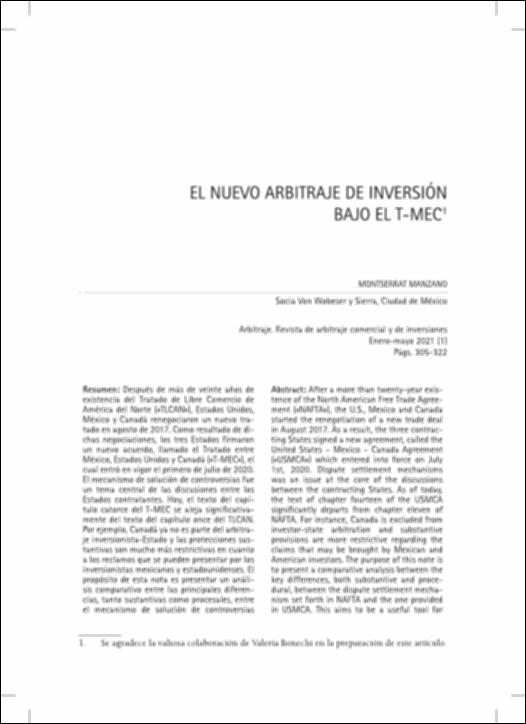Please use this identifier to cite or link to this item:
http://hdl.handle.net/10637/13629El nuevo arbitraje de inversión bajo el T-MEC.
| Title: | El nuevo arbitraje de inversión bajo el T-MEC. |
| Authors : | Manzano, Montserrat |
| Keywords: | TLCAN; T-MEC; Sistema de solución de controversias; Inversionista; Arbitraje; NAFTA; USMCA; Dispute settlement mechanisms; Investor; Arbitration |
| Abstract: | Después de más de veinte años de
existencia del Tratado de Libre Comercio de
América del Norte («TLCAN»), Estados Unidos,
México y Canadá renegociaron un nuevo tratado en agosto de 2017. Como resultado de dichas negociaciones, los tres Estados firmaron
un nuevo acuerdo, llamado el Tratado entre
México, Estados Unidos y Canadá («T-MEC»), el
cual entró en vigor el primero de julio de 2020.
El mecanismo de solución de controversias fue
un tema central de las discusiones entre los
Estados contratantes. Hoy, el texto del capítulo catorce del T-MEC se aleja significativamente del texto del capítulo once del TLCAN.
Por ejemplo, Canadá ya no es parte del arbitraje inversionista-Estado y las protecciones sustantivas son mucho más restrictivas en cuanto
a los reclamos que se pueden presentar por los
inversionistas mexicanos y estadounidenses. El
propósito de esta nota es presentar un análisis comparativo entre las principales diferencias, tanto sustantivas como procesales, entre
el mecanismo de solución de controversias. After a more than twenty-year existence of the North American Free Trade Agreement («NAFTA»), the U.S., Mexico and Canada started the renegotiation of a new trade deal in August 2017. As a result, the three contracting States signed a new agreement, called the United States – Mexico – Canada Agreement («USMCA») which entered into force on July 1st, 2020. Dispute settlement mechanisms was an issue at the core of the discussions between the contracting States. As of today, the text of chapter fourteen of the USMCA significantly departs from chapter eleven of NAFTA. For instance, Canada is excluded from investor-state arbitration and substantive provisions are more restrictive regarding the claims that may be brought by Mexican and American investors. The purpose of this note is to present a comparative analysis between the key differences, both substantive and procedural, between the dispute settlement mechanism set forth in NAFTA and the one provided in USMCA. This aims to be a useful tool for both professionals and academics looking for a general overview of the modifications of the treaty. |
| Description: | En: Arbitraje: revista de arbitraje comercial y de inversiones. eISSN. 2603-9281. vol. 13, n. 1, 2021, pp 305-323 |
| URI: | http://hdl.handle.net/10637/13629 |
| Rights : | http://creativecommons.org/licenses/by-nc-nd/4.0/deed.es |
| Issue Date: | 1-May-2021 |
| Appears in Collections: | 2021 Arbitraje nº 1 |
Items in DSpace are protected by copyright, with all rights reserved, unless otherwise indicated.


